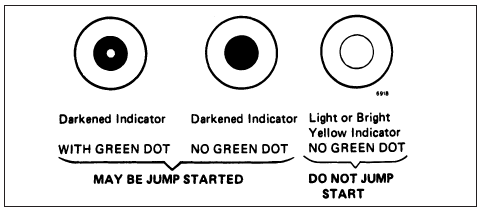Opel Corsa B 1993–2000 Service and Repair Manual: Battery - testing and charging
Standard and low maintenance battery - testing
1. If the vehicle covers a small annual mileage it is worthwhile checking the specific gravity of the electrolyte every three months to determine the state of charge of the battery.
Use a hydrometer to make the check and compare the results with the following table.
Note that the specific gravity readings assume an electrolyte temperature of 15ºC (60ºF); for every 10ºC (48ºF) below 15ºC (60ºF) subtract 0.007. For every 10ºC (48ºF) above 15ºC (60ºF) add 0.007.
Ambient temperature, 25ºC (77ºF)

2. If the battery condition is suspect, first check the specific gravity of electrolyte in each cell. A variation of 0.040 or more between any cells indicates loss of electrolyte or deterioration of the internal plates.
3. If the specific gravity variation is 0.040 or more, the battery should be renewed. If the cell variation is satisfactory but the battery is discharged, it should be charged as described later in this Section.
Maintenance-free battery - testing
4. In cases where a "sealed for life" maintenance-free battery is fitted, topping-up and testing of the electrolyte in each cell is not possible. The condition of the battery can therefore only be tested using a battery condition indicator or a voltmeter.
5. A Delco type maintenance-free battery is fitted with a built-in charge condition indicator. The indicator is located in the top of the battery casing, and indicates the condition of the battery from its colour. If the indicator shows green, then the battery is in a good state of charge. If the indicator turns darker, eventually to black, then the battery requires charging, as described later in this Section. If the indicator shows clear/yellow, then the electrolyte level in the battery is too low to allow further use, and the battery should be renewed. Do not attempt to charge, load or jump start a battery when the indicator shows clear/yellow (see illustration).

Battery condition indicator on maintenance-free type battery
6. If testing the battery using a voltmeter, connect the voltmeter across the battery and compare the result with those given in the Specifications under "charge condition". The test is only accurate if the battery has not been subjected to any kind of charge for the previous six hours. If this is not the case, switch on the headlights for 30 seconds, then wait four to five minutes before testing the battery after switching off the headlights. All other electrical circuits must be switched off, so check that the doors and tailgate are fully shut when making the test.
7. If the voltage reading is less than 12.2 volts, then the battery is discharged, whilst a reading of 12.2 to 12.4 volts indicates a partially discharged condition.
8. If the battery is to be charged, remove it from the vehicle and charge it as described later in this Section.
Standard and low maintenance battery - charging
Note: The following is intended as a guide only. Always refer to the manufacturer's recommendations (often printed on a label attached to the battery) before charging a battery.
9. Charge the battery at a rate of 3.5 to 4 amps and continue to charge the battery at this rate until no further rise in specific gravity is noted over a four hour period.
10. Alternatively, a trickle charger charging at the rate of 1.5 amps can safely be used overnight.
11. Specially rapid `boost' charges which are claimed to restore the power of the battery in 1 to 2 hours are not recommended, as they can cause serious damage to the battery plates through overheating.
12. While charging the battery, note that the temperature of the electrolyte should never exceed 37.8ºC (100ºF).
Maintenance-free battery - charging
Note: The following is intended as a guide only. Always refer to the manufacturer's recommendations (often printed on a label attached to the battery) before charging a battery.
13. This battery type takes considerably longer to fully recharge than the standard type, the time taken being dependent on the extent of discharge, but it can take anything up to three days.
14. A constant voltage type charger is required, to be set, when connected, to 13.9 to 14.9 volts with a charger current below 25 amps. Using this method, the battery should be usable within three hours, giving a voltage reading of 12.5 volts, but this is for a partially discharged battery and, as mentioned, full charging can take considerably longer.
15. If the battery is to be charged from a fully discharged state (condition reading less than 12.2 volts), have it recharged by your Vauxhall dealer or local automotive electrician, as the charge rate is higher and constant supervision during charging is necessary.
 General information and
precautions
General information and
precautions
General information
The engine electrical system consists
mainly of the charging and starting systems.
Because of their engine-related functions,
these components are covered separately
from th ...
 Battery - removal and refitting
Battery - removal and refitting
Removal
1. The battery is located on the left-hand side
of the engine bay.
2. Slacken the clamp nut and bolt on the
negative (-) terminal clamp (see illustration).
Lift the clamp off the termin ...
See also:
Opel Corsa Owners Manual. Tyre repair kit
Minor damage to the tyre tread or
sidewall can be repaired with the tyre
repair kit.
Do not remove foreign bodies from
the tyres.
Tyre damage exceeding 4 mm or that
is at tyre's sidewall near th ...
